Surf’s up in Mompiche: Ecuador’s offbeat surfer nirvana. Here’s a comprehensive guide to exploring Mompiche, including how to get there, where to sleep, and what to do in March during the rainy season.
A SURFER’S GUIDE TO EXPLORING MOMPICHE, ECUADOR
DATE: 20 MAY 2023 #travel guide
A boy on a bike in Mompiche. Shot by @judithodm
Surf’s up in Mompiche. This modest surf town left a mark in my heart, and remains one of my favourite places in South America.
Sometimes, our most cherished memories aren’t just determined by the beauty of a destination, but rather by the depth of the experiences we share and the connections we form on the road. This is what I learned in Mompiche, during one delightful month of simple living.
I wrote a lot during this trip - here’s a few honest excerpts from my travel journal. Or skip the travel stories and jump straight to my comprehensive guide to exploring Mompiche as a surfer or solo backpacker, including how to get there, where to sleep, where to surf, and what to do during the rainy season.
IMPORTANT : Ecuador is facing a rise in gang violence since January 2024. Please exercise caution when considering trips to Ecuador; refer to your local government's travel recommendations and stay informed about the evolving situation. Check Facebook groups with local communities of foreigners to get up to date information about the local situation.
TRAVEL LOG
The bus
I take a bus and leave the country's most dangerous city, Esmeraldas. Instantly, I'm transported by the joie de vivre of its passengers: kids laughing with their mothers, people chatting with their seat neighbours. A passionate Argentinian musician suddenly stands up and starts playing the guitar, and the passengers all begin singing in unison what seems to be a popular local song.
I had never seen such euphoria in a bus full of strangers. Few knew each other, yet no one was faking it or judging each other—only genuine smiles and unfiltered happiness. And so I smiled too, and listened to the bus choir, thinking, "Yes! This is exactly where I need to be."
We cross emerald landscapes, where tiny bamboo houses dot the scenery, delicate enough that a mere gust of wind could shake their foundations. Stretching from one horizon to the other, a verdant embroidery of countless tree species presented a fascinating contrast with Cali, Colombia's salsa capital, where I was just a day before.
Outside, the birds are so loud I hear them over the roaring bus motor. A sticky, salty mist in the air tickles my taste buds as I feel the ocean getting closer. And the closer we get to the water, the poorer the villages seem.
The aftermath of the 2016 earthquake exposes the harsh realities of daily life in this region. The coastline is covered with remnants of collapsed houses, rubble and abandoned roads. Some families still live in emergency shelters: black tarps and ridged metal sheets serve as walls, and pieces of tattered sheets act as roofs. A thin blanket covers the ground, offering a frail layer of protection against the mud below.
And yet, I see children playing and laughing, locals smiling as the bus passes their humble slum, and elderly folks chatting on a tire by the roadside. Joy amid the ruins.
I had never seen such euphoria in a bus full of strangers. Few knew each other, yet no one was faking it or judging each other—only genuine smiles and unfiltered happiness. And so I smiled too, and listened to the bus choir, thinking, "Yes! This is exactly where I need to be."
We cross emerald landscapes, where tiny bamboo houses dot the scenery, delicate enough that a mere gust of wind could shake their foundations. Stretching from one horizon to the other, a verdant embroidery of countless tree species presented a fascinating contrast with Cali, Colombia's salsa capital, where I was just a day before.
Outside, the birds are so loud I hear them over the roaring bus motor. A sticky, salty mist in the air tickles my taste buds as I feel the ocean getting closer. And the closer we get to the water, the poorer the villages seem.
The aftermath of the 2016 earthquake exposes the harsh realities of daily life in this region. The coastline is covered with remnants of collapsed houses, rubble and abandoned roads. Some families still live in emergency shelters: black tarps and ridged metal sheets serve as walls, and pieces of tattered sheets act as roofs. A thin blanket covers the ground, offering a frail layer of protection against the mud below.
And yet, I see children playing and laughing, locals smiling as the bus passes their humble slum, and elderly folks chatting on a tire by the roadside. Joy amid the ruins.
The singer has stopped singing. He collects money, sweets, smiles, and words of gratitude before sitting at the back of the bus.
At each stop, the bus becomes a bustling marketplace as vendors step on board, selling all sorts of curiosities: a cream for curing cancer, a necklace to find love, and chocolates for luck and prosperity. They leave a "sample" in each passenger's hands for the journey's duration before retrieving it and testing their luck at another bus stop. The necklace for love finds the most eager buyers.
As my eyes wander among the conversing passengers, I'm captivated by a mosaic of new faces with unfamiliar features— quirky and outdated haircuts, but beautiful and delicate physiques, almond-shaped eyes with long lashes, dazzling teeth, caramel-coloured skin, like the rich hue of a setting sun, and petite and straight noses. An unexpected,
elegant blend of European, Latino, and African influences.
At each stop, the bus becomes a bustling marketplace as vendors step on board, selling all sorts of curiosities: a cream for curing cancer, a necklace to find love, and chocolates for luck and prosperity. They leave a "sample" in each passenger's hands for the journey's duration before retrieving it and testing their luck at another bus stop. The necklace for love finds the most eager buyers.
As my eyes wander among the conversing passengers, I'm captivated by a mosaic of new faces with unfamiliar features— quirky and outdated haircuts, but beautiful and delicate physiques, almond-shaped eyes with long lashes, dazzling teeth, caramel-coloured skin, like the rich hue of a setting sun, and petite and straight noses. An unexpected,
elegant blend of European, Latino, and African influences.

I'm captivated by a mosaic of new faces with unfamiliar features— quirky and outdated haircuts, but beautiful and delicate physiques, almond-shaped eyes with long lashes, dazzling teeth, caramel-coloured skin, like the rich hue of a setting sun, and petite and straight noses.
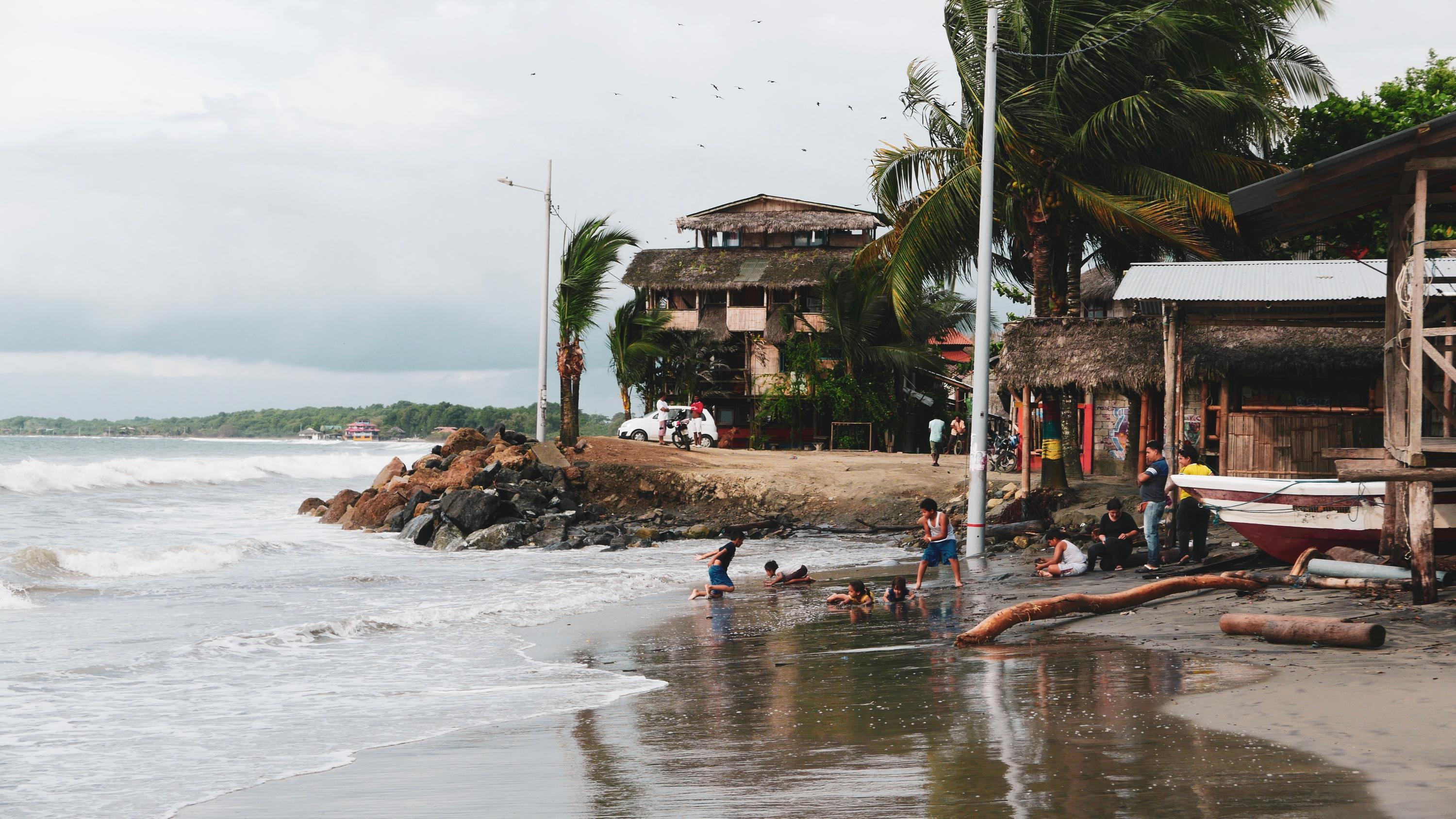
Shot by @judithodm
Arrival in Mompiche: The village, 7PM
I hop off the bus and land on a muddy street, gloomy and deserted, except for a dozen stray dogs with skeletal bodies. A worn-down motel with aggressive flashing neon lights sits in the central square, like a scene from a horror movie. I ask myself what the hell I'm doing here. But the sound of the waves is here, so close...
I check into my hostel and fall asleep in my dorm bed, hoping the daylight will paint a better picture of what I’ve just seen.
The Next Day
A grey, damp, and cloudy sky.
Mompiche looks like a ghost town...dead fish strew its beaches at low tide, some of which are lethal if stepped upon. A shabby hostel threatens to collapse facing "El Río," one of the surf spots to the village's right.
But something draws me in...
Suddenly, a smile, a burst of laughter, a warm glance reveal the true colours of this seemingly gloomy village.
And it shines brightly!
The streets illuminate with cheering “Holas.” The sea sends us its most beautiful waves—gentle, at times wild and playful—creating moments of pure bliss. The abandoned hostel invites us to imagine wild tales as we pass through its doors battered by the sea, discovering the objects of its former occupants, rusted by salt but still alive with their stories.
Radiant joy reigns everywhere. The locals and travellers are happy here. Their daily lives' opulent simplicity oozes a contagious vitality.
And so I stayed for a month, volunteering for a charming hostel. I crossed paths with some fascinating individuals and forged intense connections with the town and its people.
In that precious month, I discovered the true roots of Mompiche—a humble surf town pulsating with authenticity, resilience, and the purest expressions of human connection.
Mompiche reminded me that the richness of our experiences isn’t solely determined by the external beauty of a place, but rather by the meaningful connections we build with the people we meet.
Your best memories might come from a slum in India rather than a posh villa in Bali. While Mompiche isn't a town that'll make it in Condé Nast Traveller, it has left a mark on many backpackers. Because it's a simple reminder that we don't need much to be happy.
And so I stayed for a month, volunteering for a charming hostel. I crossed paths with some fascinating individuals and forged intense connections with the town and its people.
In that precious month, I discovered the true roots of Mompiche—a humble surf town pulsating with authenticity, resilience, and the purest expressions of human connection.
Mompiche reminded me that the richness of our experiences isn’t solely determined by the external beauty of a place, but rather by the meaningful connections we build with the people we meet.
Your best memories might come from a slum in India rather than a posh villa in Bali. While Mompiche isn't a town that'll make it in Condé Nast Traveller, it has left a mark on many backpackers. Because it's a simple reminder that we don't need much to be happy.
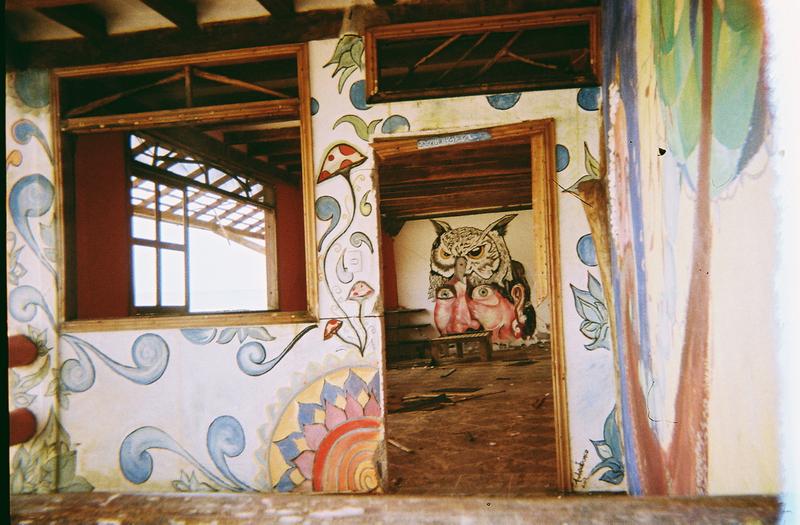
The abandoned hostel facing El Rio
In that precious month, I discovered the true roots of Mompiche—a humble surf town pulsating with authenticity, resilience, and the purest expressions of human connection.
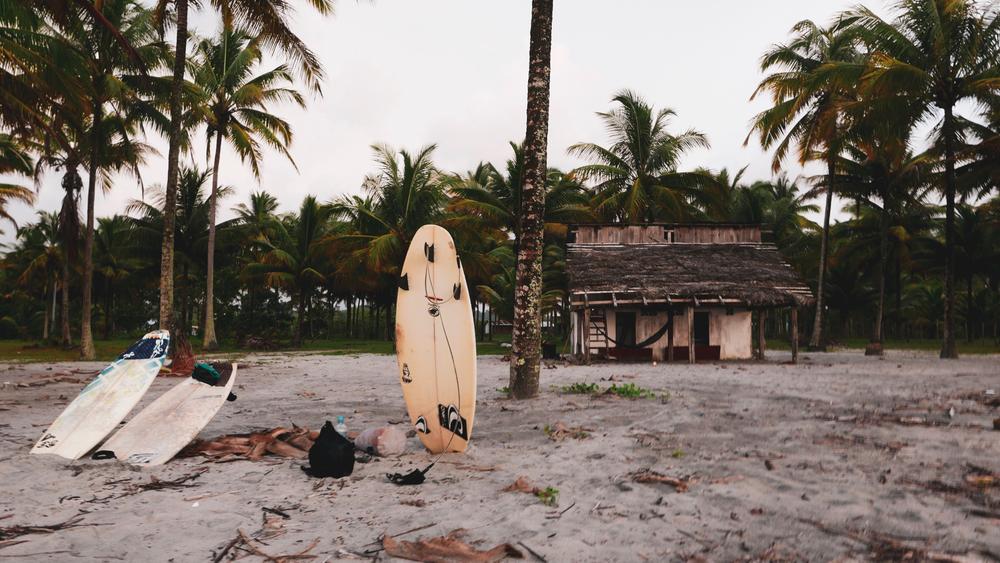
Surfing Mompiche shot by @judithodm
Playa Negra shot by @judithodm
TRAVEL GUIDE
A Solo Backpacker's Guide to Surfing Mompiche in the Rainy Season
If you're a solo backpacker seeking an authentic South American experience, this little fishermen’s town in Ecuador will soothe your thirst for world-class waves away from the crowds. Here’s all you need to know to plan your surf trip to Mompiche.
Where’s Mompiche in Ecuador?
Mompiche is a small fishing village in the Esmeraldas province on Ecuador's Pacific coast.
Mompiche weather & the best time to visit
The best time to visit Mompiche is during the dry season, which runs from June to November. During this time, the weather is mostly sunny with occasional rain showers. Temperatures range from 25-30°C (77-86°F) during the day and can drop to 18-20°C (64-68°F) at night. But the best time to surf in Mompiche is during the rainy season, from January to March, when swells are the most consistent.
I visited Mompiche in March, during the rainy season. It would sometimes rain in the afternoon and at night, but every morning was sunny except for some rare exceptions. The weather fluctuated quickly, but it never prevented me from exploring the region and surfing every day. There were waves almost every single day, from hip to overhead.
The only drawback was the crazy amount of mosquitos. I got bitten repeatedly and bites got easily infected because of the stray dogs on the streets (and you only walk barefoot in Mompiche), so put mosquito repellent at all times.
How to get to Mompiche?
The most common way to get to Mompiche is by bus. Buses depart regularly from Quito's main bus terminal and other major cities in Ecuador. The bus ride takes about 6-8 hours from Quito, depending on traffic and road conditions. There is a night direct bus from Quitumbe station with the Kennedy company. Or you can take a direct bus to Atacames from Quito, then a short bus or taxi to Mompiche, if you want to avoid Esmeraldas.
I took a bus from Esmeraldas, a less common route for backpackers, as the city is one of the most dangerous in Ecuador. But since I had to cross the border from Colombia, it was the fastest and easiest route for me. The bus ride lasted around 2h30 and was really cheap.
Do businesses accept cards in Mompiche?
There are no ATMs in Mompiche, and the closest one is in Atacames, which is a 3 hour round-trip. Most businesses only accept cash, so withdraw money before heading to Mompiche, and hide it in your secret money belt.
Is Mompiche safe for solo backpackers?
Mompiche is generally considered safe for solo travellers, and people in the town are welcoming and friendly. But like any other destination in South America, stay cautious and trust your gut.
Keep in mind that no matter how cautious you are, shit can happen. I got all my valuables stolen in Mompiche. Someone that was staying at the hostel had broken the locks of our dorm lockers, and took our valuables while we were surfing. I suddenly found myself with no more money to travel.
The guy had meticulously planned his move—he had been staying and chatting with us for a couple of days, acting friendly and approachable. We later learned he had been doing this in a series of hostels in South America.
People were shocked in town, as nothing like this had ever happened before. But I was blessed by the amount of support I received, from the hostel manager to fellow travellers and local surfers. Everyone offered to help, and their kindness and compassion were heart-warming. Fortunately, I also had a travel insurance that covered all stolen items.
Word of advice? Get a really sturdy lock for your dorm locker.
Where to surf in Mompiche?
Mompiche is home to some of the best waves in Ecuador. It's perfect for all levels and you can surf year round. Although, if you’re a beginner, try to avoid going there from September to February, when the biggest swells hit.
There's three main surf spots in the area:
Playa Negra: Situated about 2.5km from the town, it's a stunning beach break with black sand. You can surf lefts and rights, and the spot is often uncrowded. Works best at high tide.
La Punta: La Punta is the beach on the far left of Mompiche. It's a point-break that offers a long peeling left, sometimes tubular when there's a big swell. It works best at low tide. If you're a beginner, you can surf a bit further up front, where you get the leftovers from the bigger sets breaking in the back. It's a great spot to practice and improve your skills in a more manageable and inclusive environment. Just watch out for stingrays!
El Rio: This spot is to the town's right, a bit further up the river mouth opening. It's a beach break that works best at mid-tide. It’s where I surfed the most. I’d arrive around 6 AM before my work shift, and the waves would always set the tone for a wonderful day.
If you don’t have your surfboards with you, you can rent some in town. There were two or three shops when I visited in 2019, but there may be more now. There wasn’t lots of choice, so bring your surf gear with you if you can.
Local surfers were super friendly, and were happy to help us outand give us tips to improve.

What to eat in Mompiche?
Mompiche is known for its fresh seafood, including ceviche and grilled fish. You can also find traditional Ecuadorian dishes like llapingachos and empanadas. Depending on the season, the town has a few restaurants that come and go.
When I was there, there was a veggie restaurant that served delicious pancakes, and a local fisherman who had a 3€ menu for one appetizer, fresh fish with coconut rice, veggies and pressed maracuja juice.
In terms of groceries, you can only buy the bare necessities in the town. You won’t find fancy imported stuff, and even avocados were a rare find. A veggie van would come once every two weeks with fresh fruit and avocados, and we'd hear people scream in the streets, "Avocados"! Blond gringos would then rush to buy a pair or two. The fact we had to wait for the avocados to come made them so much tastier.
What to do in Mompiche?
Mompiche is a great place to relax and enjoy the waves, but you can also go fishing, kayaking in the mangroves and visit nearby natural reserves. At night, when it’s pitch black, head to the far left of the main beach. You’ll find a path of glimmers at your feat: plankton. Tiny wonders of nature that transform the sand into a stellar sky.
Mompiche is big on eco-conscious living and eco-friendly tourism. There’s many community projects going on to protect the town from over-tourism and cherish the rich fauna and flora in the province. That's why it's a fantastic place for solo backpackers because it's packed with meaningful volunteering opportunities.
Where to stay in Mompiche?
Best Hostel in Mompiche for Solo Backpackers
Mompiche has plenty of cool hostels for solo travellers. But I can only recommend one, since it’s where I volunteered for a month, and could call home after just a few days staying there.
The Mudhouse Mompiche
![eco-friendly surf house in Mompiche Ecuador: The Mudhouse]()
This is where I volunteered for a month. I had a fantastic stay there. It’s an eco-hostel with a lush garden, a short walk from the town center. Consciously crafted bamboo houses and bungalows are separated by delicate paths, each with their private outdoor shower. There’s a well-equipped communal kitchen and a deck with hammocks that’s perfect for meeting other people.
What I loved about The Mudhouse was that it felt like we were living outside. There were no windows, everything was open and in perfect communion with nature. You’d wake up with the sun light shining through the bamboo walls, and the fresh evening breeze at night.
They have dorms, private rooms and bungalows. The dorm beds were very comfy; I slept very well in Mompiche, much better than in other countries.
Book your stay at The Mudhouse Mompiche︎︎︎
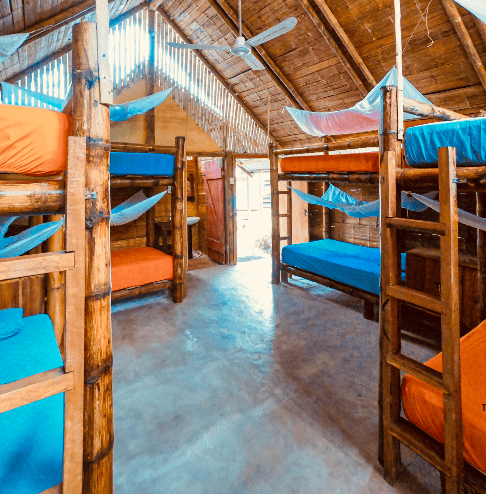

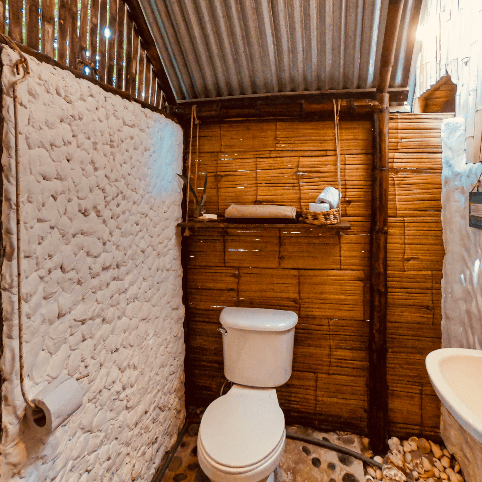

All pictures from The Mudhouse website
Best Airbnbs in Mompiche
It’s hard to choose as there’s so many gorgeous options. Here’s a roundup of the most beautiful Airbnbs you can stay at in Mompiche. You’ll notice a strong bamboo trend - that’s because most houses are built with a locally-grown bamboo called Guadua. And it’s a feast for the eyes.
PUNTA DE ENCUENTRO Beachfront Guest House (private rooms)
This Airbnb is right next to the surf spots and the town center. If it’s still open, there’s a delicious restaurant right below where you can easily meet other solo backpackers. It boasts large rooms, lots of hammocks, stunning ocean views and all the commodities you need for a perfect stay in Mompiche, especially if you’re travelling solo but need some privacy, while still having shared facilities to meet other people.
Book your stay at Punta de Encuentro Mompiche ︎︎︎
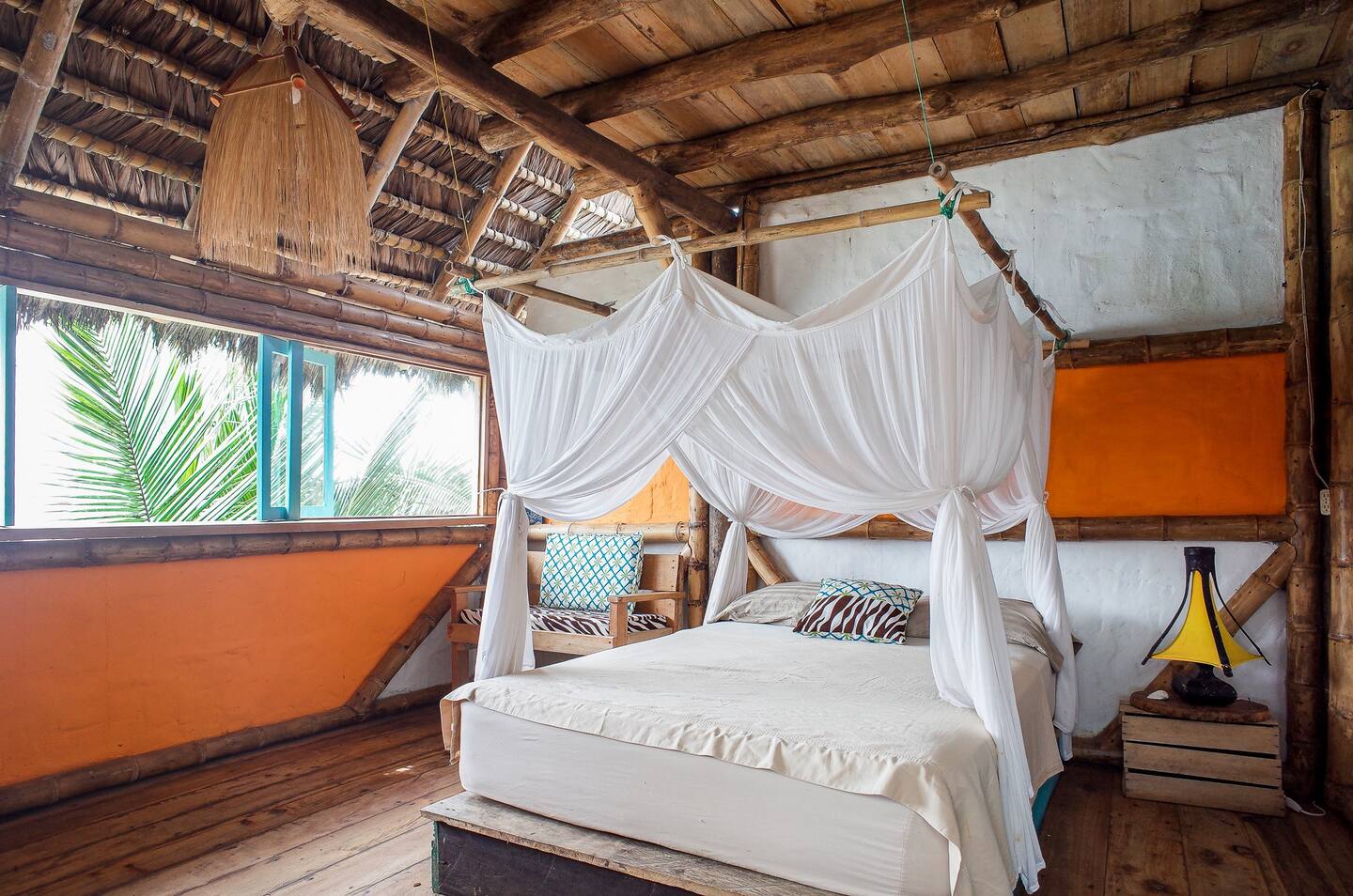


All pictures from Airbnb
Amy’s Bamboo Tree House in Mompiche: A surfer paradise

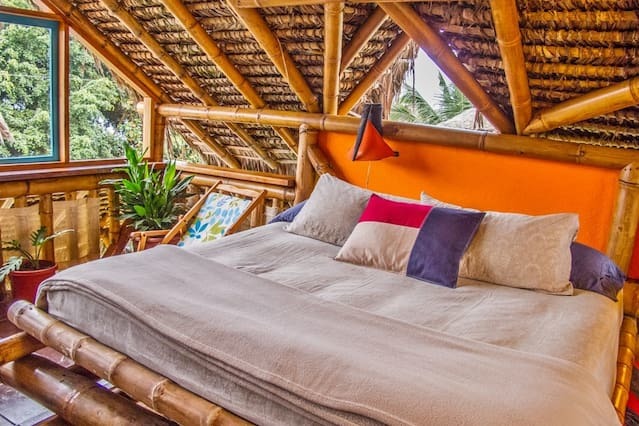
I mean, if I had a dream house, this would be it. That kitchen! That bathroom! The views! With four rooms, three floors, open-air showers and world-class surf spots steps away, this eco-tropical bamboo house with Afro-Ecuadorian vibes is a true gem in Mompiche. It's perfect if you're travelling with friends. If you have to work remotely, you'll have high-speed wi-fi. Just imagine the faces of your colleagues when they see your background on that video call... This Airbnb has been on my wish list for a while. Let me know how it goes if you manage to get there :)
Book your stay at the Bamboo Treehouse ︎︎︎



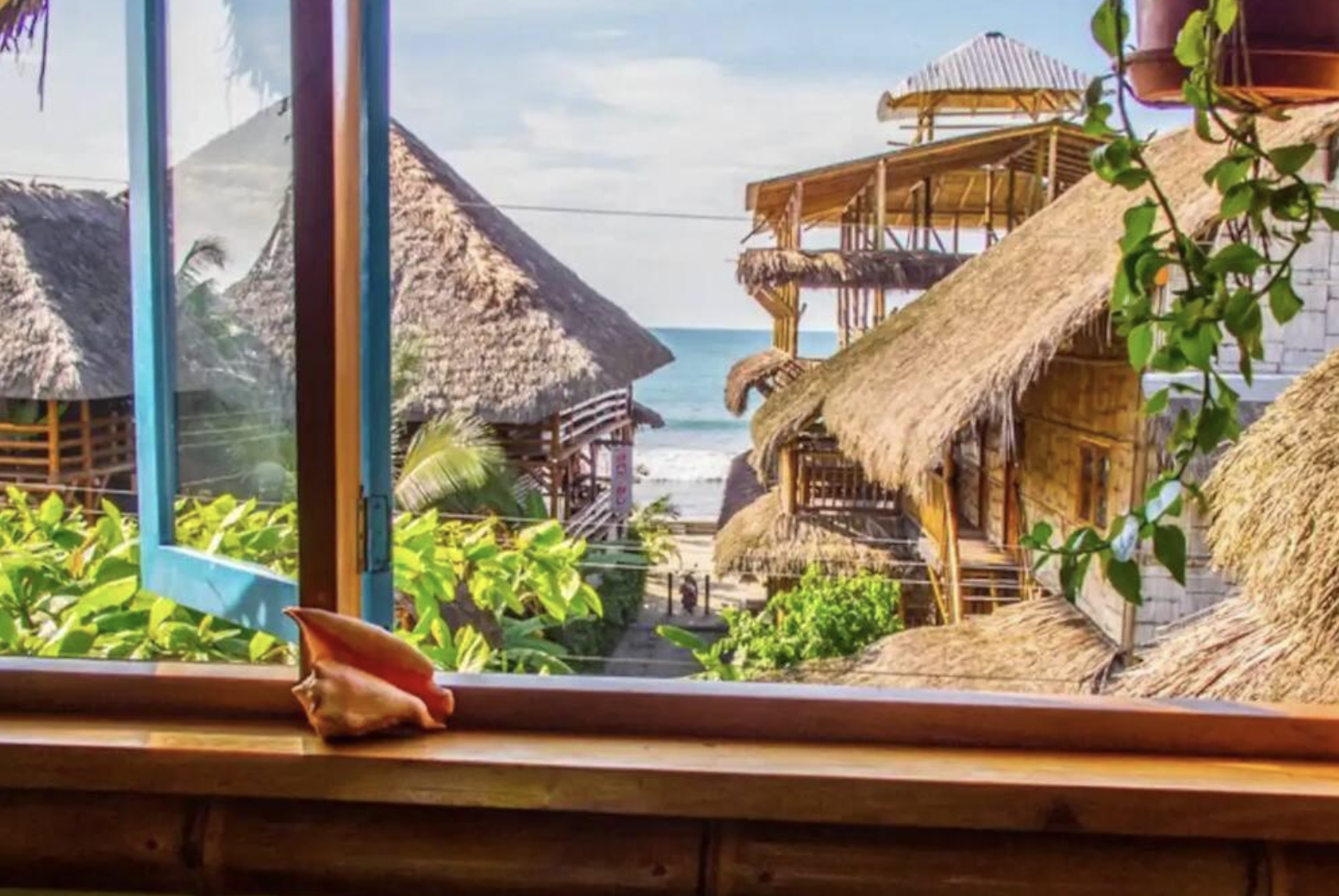


All pictures from Booking.com
Special mention: Casa Toquilla on Isla Portete
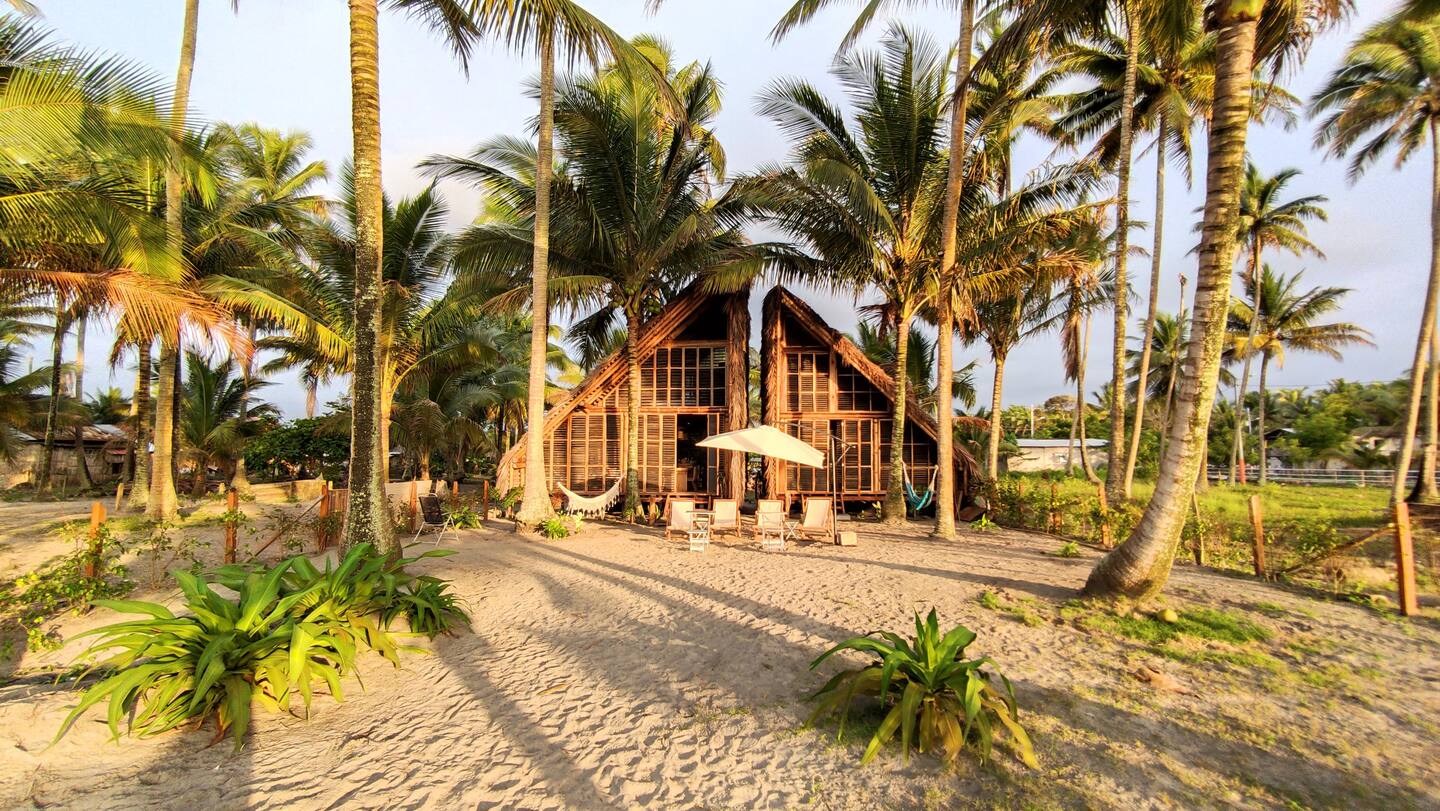
Now this is unlike what I've ever seen before. It's technically not in Mompiche (5 minutes away by boat), but it’s a work of art. It's also not as expensive as it looks (70€/night during the low season, and it has 8 beds!). So if you're into an off-the-grid adventure, maybe rent this cabin for a few days. Like the others mentioned above, it's thoughtfully crafted, featuring eco-conscious materials, open and fluid spaces, without any doors or walls except for the bathrooms. Read through the Airbnb description to teleport into this green oasis by the sea.
Discover Casa Toquilla ︎︎︎

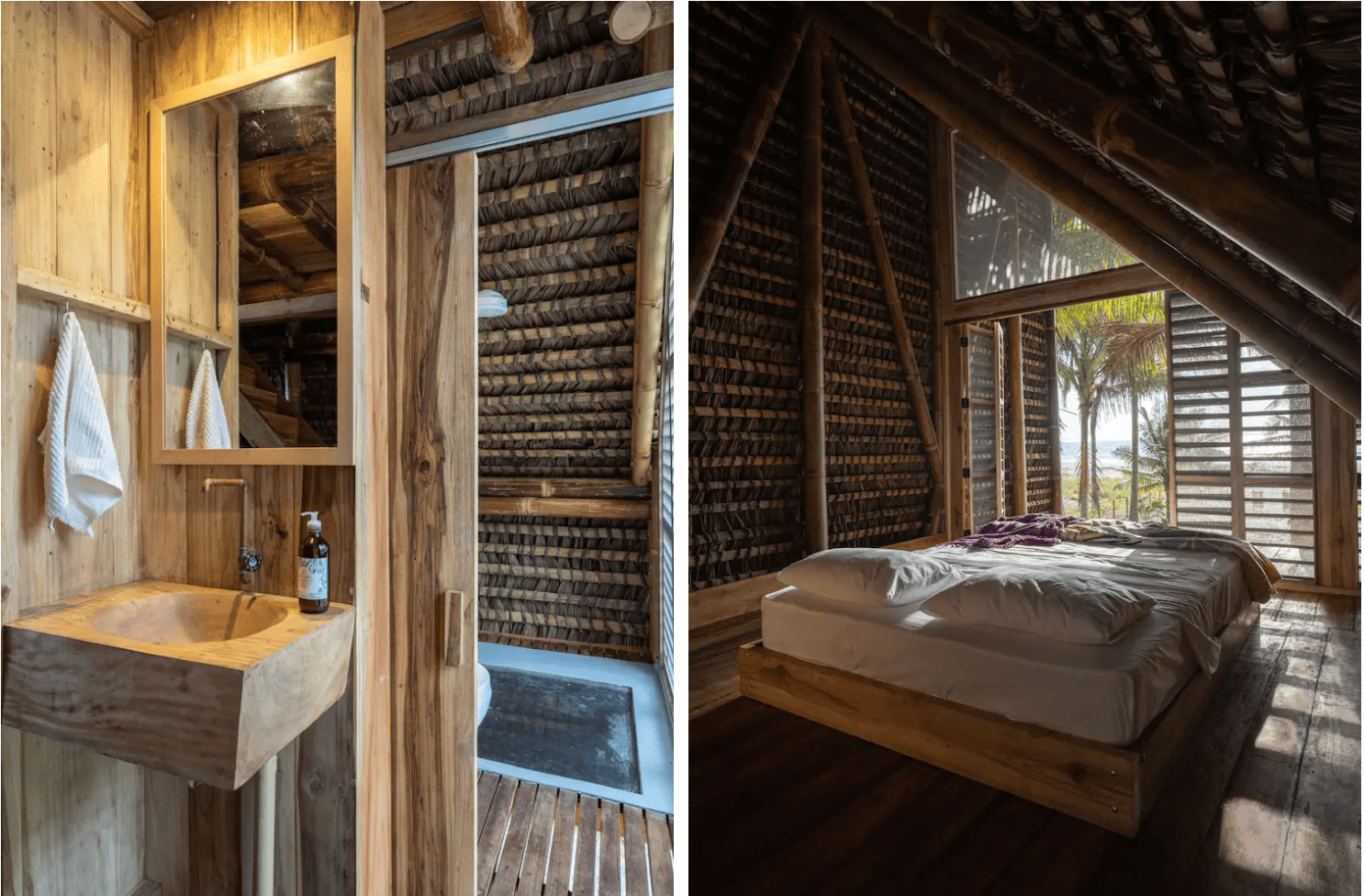


“I wish I knew this before I went there”
To top it off, here’s some useful safety travel tips to get to Mompiche in one piece (and with all your valuables). Although Mompiche is safe for solo travellers, the surrounding area isn’t. So keep your eyes open, and try not to sleep on the bus while getting there.
- Petty theft is common, so keep an eye on your belongings. I met at least four people who had their backpack stolen in the bus from Quito.
- Hold your small backpack close to you, on your lap, rather than on the floor.
- Try to sit on the side of the bus luggage compartment where you put your big backpack, and stay alert during bus stops. Choose a seat close to an exit.
- Don't flaunt your valuables. Keep your passport, cash and credit cards in a secret money belt, and any electronic equipment in your small backpack - the one that stays with you on the bus, not in the storage below.
- Have a lock on both bags.
- I used a cover bag to make my large backpack less noticeable. It looked like a basic bag, and unless people saw me enter the bus, no one would guess it had a backpack inside. It's also great because you can lock it, whereas locking a backpack is almost impossible because of the different openings. Good options include this cover bag from Decathlon.
- Mompiche doesn’t have any ATMs (although that may have changed since then). And the closest one is a two-hour round-trip by bus. Bring cash with you, but don’t store all your cash in one place. Strategically hide it in different zipped pockets, wallets and inside your secret belt.
- Get a travel insurance! Mine covered the cost of my stolen camera and laptop—well beyond what I paid for the 7-month insurance plan. I also got a serious foot infection from surfing, and my insurance covered all medical expenses, which can get pricey in South America, especially if you travel to remote places. Good options include SafetyWing for North Americans, and Chapka Assurance for Europeans.

Mompiche shot by @judithodm
So what do you think? Does this seem like a surf town you’d love to explore? If yes, add it to your itinerary wish list :)
If you do go to Mompiche, I’d love your feedback on the town. Although I’ve heard it kept its laid-back vibe, I wonder if it’s going through the same gentrification process all surf towns eventually go through. I hope not...you’ll tell me if I should head back or not!
In the meantime, here’s some handy resources to help you plan for your next trip:
📖 a snazzy ebook detailing how to prep a long-term solo backpacking trip in 20 steps
🗺️ a long-term backpacking trip planner on Notion to travel with peace of mind (including useful tools like a travel budget worksheet, a pre-departure task list and a packing list for multiple climates)
🌐 an unusual South America 6-month trip itinerary crossing 40 stops from Costa Rica to Brazil
And more!
🗺️ a long-term backpacking trip planner on Notion to travel with peace of mind (including useful tools like a travel budget worksheet, a pre-departure task list and a packing list for multiple climates)
🌐 an unusual South America 6-month trip itinerary crossing 40 stops from Costa Rica to Brazil
And more!
Image Credits:
Images 1, 2, 3, 5, 7, 8 captured by the wonderful @judithodm
When mentionned: images taken from Airbnb
When there’s no mention: images owned by me
